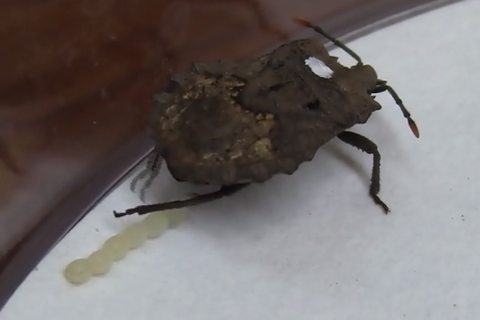What looked like a hearing organ on a tiny stinkbug’s leg turned out to be something far stranger: a fungal nursery that mother bugs use to coat their newly laid eggs in protective symbiotic hyphae, shielding their offspring from parasitic wasps.

Tympanal organs have repeatedly evolved in many insect species and are often considered to be used for sensing sound. Previous studies have reported a conspicuously enlarged structure on the real legs of adult female dinidorid stinkbugs, which has long been interpreted as a tympanal organ.
Dinidoridae are a small group of stinkbugs containing roughly 100 species, many of which suffer from wasp parasitism. However, according to the authors, no other stinkbug groups are known to have these female-specific hindleg structures. To determine the function of this presumed tympanum, Takanori Nishino and colleagues investigated the Japanese dinidorid stinkbug Megymenum gracilicorne and found that its hindleg organ is not used for hearing, but instead represents a previously unknown type of symbiotic organ.
READ MORE: Beewolves protect symbiont microbes from toxic gas release
READ MORE: Revealed: How fungus-farming termites protect gardens from invaders
To address this question, researchers investigated the Japanese dinidorid stinkbug Megumenum gracilicorne and found that its so-called “tympanal organ” is not an auditory organ but instead a novel symbiotic organ.
Benign Cordyceps-like fungi
The authors observed that, in reproductively mature females, the “tympanal organ” was covered with fungal hyphae which were benign Cordyceps-allied filamentous fungi selectively acquired from the environment every generation. Strikingly, while laying eggs, the females skillfully transferred the fungi from the organ to the eggs.
Then, the eggs were quickly covered with fungal hyphae. The fuzzy hyphal thickets physically prevented wasps from approaching, thereby protecting the eggs from parasitism. When hypha-covered and hypha-removed eggs were presented to parasitic wasps in both laboratory and field experiments, the fungus-covered eggs consistently showed lower parasitism rates, verifying effective defense against the natural enemy by the egg-covering hyphae.
They also examined diverse dinidorid stinkbugs collected from Taiwan and a southwestern island of Japan and found that all of these species possess the female-specific hindleg organs and exhibit the egg-smearing behaviors. Hence, the hindleg organ and the egg-smearing behavior must have evolved in the common ancestor of the Dinidoridae.
Unexpected discovery
In conclusion, the re-examination of the female-specific “tympanal organ”, which has been known from dinidorid stinkbugs for decades, led to the unexpected discovery of novel external fungal symbiosis that provides physical defense against wasp parasitism.
The previous interpretation that the female-specific hindleg organ might be a tympanal ear was based merely on superficial morphological resemblance. This defensive fungal symbiosis on insect hindlegs provides an impressive example of how evolutionarily novel traits for microbial symbiosis emerge, develop, and constitute the elaborate syndrome that integrates molecular, cellular, morphological and behavioral specializations.
Topics
- Asia & Oceania
- Dinidoridae
- Ecology & Evolution
- Fungi
- Healthy Land
- hyphae
- Japanese dinidorid stinkbug
- Megumenum gracilicorne
- National Institute of Advanced Industrial Science and Technology
- Research News
- symbiosisMax Planck Institute for Marine Microbiology
- Takanori Nishino
- tympanal organ
- Veterinary Medicine & Zoonoses







No comments yet